Enhancement of the Concrete Durability with Hybrid Nano Materials
Abstract
1. Introduction
2. Experimental Program
2.1. Material
2.2. Mixing Procedure and Mixture Constituents
2.3. Testing
3. Test Results and Discussion
3.1. Air Content
3.2. Workability
3.3. Compressive Strength
3.4. Tensile Strength
3.5. Flexural Strength
3.6. Sorptivity
3.7. Water Penetration Test
3.8. Chloride Penetration Test
3.9. Corrosion Resistance
3.10. Scanning Electron Microscope (SEM)
4. Conclusions
- In the fresh stage, adding CNT% in the cementitious composites increased the air content of concrete as compared to the control mix. The consistency of concrete slightly increased with the small amounts of carbon nanotubes, while the addition of more CNT caused a decrement in the slump of concrete.
- The maximum peak of compressive strength was 26.4% with 0.04% CNT as compared to the control mix. The maximum peak of tensile strength was 40.4% with 0.02% CNT when compared to the control mix. The maximum peak of flexural strength was 15.5% with both 0.01% and 0.02% CNT when compared to the control mix. The maximum bond strength as subjected to the corrosive environment enhanced with the cement replacement 0.01% CNT as compared to the control concrete.
- The predominance of a re-agglomeration process of CNT inhibited the pozzolanic activity of NC and hindered the hydration reaction of cement at late ages, which caused a decrease in bond strength at a high percentage level of CNT.
- The mixtures incorporating CNT% showed a slight increment in sorptivity and penetration depth as compared to the control paste with the same increment trend in chloride penetration.
- From the SEM images, it was concluded that the major effects of CNTs are (1) filling effect, (2) bridging effect, and (3) nucleation as sub-centroplasm for C-S-H gel. These findings comply with the results reported from the mechanical strength and durability tests.
- Hybrid nanoparticles improve the corrosion resistance and have proven useful resistance of crack propagation within the concrete matrix. The engineering properties were significantly improved by using hybrid nanoparticles where the high pozzolanic effect of NC led to improve the mechanical strength, as long as the nanotubes were used to reinforce concrete and, hence, enhanced the durability properties. These results agreed with the measured tests.
Author Contributions
Funding
Institutional Review Board Statement
Informed Consent Statement
Data Availability Statement
Acknowledgments
Conflicts of Interest
References
- Alharbi, Y.R.; Abadel, A.A.; Salah, A.A.; Mayhoub, O.A.; Kohail, M. Engineering properties of alkali activated materials reactive powder concrete. Constr. Build. Mater. 2020, 121550. [Google Scholar] [CrossRef]
- Alharbi, Y.R.; Abadel, A.A.; Elsayed, N.; Mayhoub, O.A.; Kohail, M. Mechanical properties of EAFS concrete after subjected to elevated temperature. Ain Shams Eng. J. 2020. [Google Scholar] [CrossRef]
- Amer, I.; Kohail, M.; El-Feky, M.; Rashad, A.; Khalaf, M.A. Characterization of alkali-activated hybrid slag/cement concrete. Ain Shams Eng. J. 2020. [Google Scholar] [CrossRef]
- Elkady, H.; Serag, M.; Elfeky, M. Effect of Nano Silica De-agglomeration, and Methods of Adding Super-plasticizer on the Compressive Strength, and Workability of Nano Silica Concrete. Civ. Environ. Res. 2013, 3, 21–34. [Google Scholar]
- El-tair, A.M.; Sharobim, K.G.; Mohammedin, H.; Kohail, M. Improving The Reactivity Of Clay Nano-Partciles In High Strength Mortars Through Indirect Sonication Method. Int. J. Sci. Technol. Res. 2020, 9, 1045–1054. [Google Scholar]
- Rashad, A.M. Effect of nanoparticles on the properties of geopolymer materials. Mag. Concr. Res. 2019, 71, 1283–1301. [Google Scholar] [CrossRef]
- Hamed, N.; El-Feky, M.; Kohail, M.; Nasr, E.-S.A. Effect of nano-clay de-agglomeration on mechanical properties of concrete. Constr. Build. Mater. 2019, 205, 245–256. [Google Scholar] [CrossRef]
- El-Feky, M.; Kohail, M.; El-Tair, A.; Serag, M. Effect of microwave curing as compared with conventional regimes on the performance of alkali activated slag pastes. Constr. Build. Mater. 2020, 233, 117268. [Google Scholar] [CrossRef]
- Amer, I.; Kohail, M.; Rashad, A.; Khalaf, M.A. Evaluation Of Using Cement In Alkali-Activated Slag Concrete. Int. J. Sci. Technol. Res. 2020, 9, 245–248. [Google Scholar]
- Abdelmonem, A.; El-Feky, M.; Nasr, E.-S.A.; Kohail, M. Performance of high strength concrete containing recycled rubber. Constr. Build. Mater. 2019, 227, 116660. [Google Scholar] [CrossRef]
- El-Feky, M.S.; El-Tair, A.M.; Kohail, M.; Serag, M.I. Nano-Fibrillated Cellulose as a Green Alternative to Carbon Nanotubes in Nano Reinforced Cement Composites. Int. J. Innov. Technol. Explor. Eng. 2019, 8, 484–491. [Google Scholar] [CrossRef]
- Shalby, O.B.; Elkady, H.M.; Nasr, E.A.R.; Kohail, M. Assessment of mechanical and fire resistance for hybrid nano-clay and steel fibres concrete at different curing ages. J. Struct. Fire Eng. 2019, 11, 189–203. [Google Scholar] [CrossRef]
- Alharbi, Y.R.; Abadel, A.A.; Mayhoub, O.A.; Kohail, M. Effect of using available metakaoline and nano materials on the behavior of reactive powder concrete. Constr. Build. Mater. 2021, 269, 121344. [Google Scholar] [CrossRef]
- El-Feky, M.S.; Youssef, P.; El-Tair, A.M.; Ibrahim, S.; Serag, M. Effect of nano silica addition on enhancing the performance of cement composites reinforced with nano cellulose fibers. AIMS Mater. Sci. 2019, 6, 864–883. [Google Scholar] [CrossRef]
- Hani, N.; Nawawy, O.; Ragab, K.S.; Kohail, M. The effect of different water/binder ratio and nano-silica dosage on the fresh and hardened properties of self-compacting concrete. Constr. Build. Mater. 2018, 165, 504–513. [Google Scholar] [CrossRef]
- Elkady, H.; Yasien, A.M.; Kohail, M.; Serag, M.E. Assessment of mechanical strength of nano silica concrete (NSC) subjected to elevated temperatures. J. Struct. Fire Eng. 2019, 10, 90–109. [Google Scholar] [CrossRef]
- Xie, J.; Zhang, H.; Duan, L.; Yang, Y.; Yan, J.; Shan, D.; Liu, X.; Pang, J.; Chen, Y.; Li, X.; et al. Effect of nano metakaolin on compressive strength of recycled concrete. Constr. Build. Mater. 2020, 256, 119393. [Google Scholar] [CrossRef]
- Camacho, M.D.C.; Galao, O.; Baeza, F.J.; Zornoza, E.; Garcés, P. Mechanical Properties and Durability of CNT Cement Composites. Materials 2014, 7, 1640–1651. [Google Scholar] [CrossRef]
- Said, A.; Zeidan, M.S.; Bassuoni, M.; Tian, Y. Properties of concrete incorporating nano-silica. Constr. Build. Mater. 2012, 36, 838–844. [Google Scholar] [CrossRef]
- Şimşek, B. Multi-walled carbon nanotubes with different features reinforced cement pastes: A compressive and systematic approach using principal component analysis. J. Build. Eng. 2020, 32, 101792. [Google Scholar] [CrossRef]
- Morsy, M.S.; Alsayed, S.H.; Aqel, M. Effect of Nano-clay on Mechanical Properties and Microstructure of Ordinary Portland Cement Mortar. Int. J. Civ. Environ. Eng. IJCEE-IJENS 2010, 10, 23–27. [Google Scholar]
- Sedaghatdoost, A.; Behfarnia, K. Mechanical properties of Portland cement mortar containing multi-walled carbon nanotubes at elevated temperatures. Constr. Build. Mater. 2018, 176, 482–489. [Google Scholar] [CrossRef]
- Carriço, A.; Bogas, J.A.; Hawreen, A.; Guedes, M. Durability of multi-walled carbon nanotube reinforced concrete. Constr. Build. Mater. 2018, 164, 121–133. [Google Scholar] [CrossRef]
- Sasmal, S.; Bhuvaneshwari, B.; Iyer, N.R. Can Carbon Nanotubes Make Wonders in Civil/Structural Engineering? Prog. Nanotechnol. Nanomater. 2013, 2, 117–129. [Google Scholar] [CrossRef]
- El-Feky, M.; El-Khodary, S.; Morsy, M. Optimization of Hybrid Cement Composite with Carbon Nanotubes and Nano Silica using Response Surface Design. Egypt. J. Chem. 2019, 62, 7–9. [Google Scholar] [CrossRef]
- Su, Z.; Hou, W.; Sun, Z. Recent advances in carbon nanotube-geopolymer composite. Constr. Build. Mater. 2020, 252, 118940. [Google Scholar] [CrossRef]
- Madhavi, T.C.; Pavithra, P.; Singh, S.B.; Raj, S.B.; Paul, S. Effect of Multiwalled Carbon Nanotubes On Mechanical Properties of Concrete. Int. J. Sci. Res. 2012, 2, 166–168. [Google Scholar] [CrossRef]
- Mendoza-Reales, O.A.; Gallego, G.S.; Tobón, J.I. The mechanical properties of Portland cement mortars blended with carbon nanotubes and nanosilica: A study by experimental design. DYNA 2016, 83, 136. [Google Scholar] [CrossRef]
- Alharbi, Y.R.; Galal, M.; Abadel, A.A.; Kohail, M. Bond behavior between concrete and steel rebars for stressed elements. Ain Shams Eng. J. 2020. [Google Scholar] [CrossRef]
- Shamseldein, A.; Elshafie, H.; Kohail, M.; Kohail, M. Assessment and restoration of bond strength of heat-damaged reinforced concrete elements. Constr. Build. Mater. 2018, 169, 425–435. [Google Scholar] [CrossRef]
- Ghazaly, N.; Rashad, A.; Kohail, M.; Nawawy, O. Evaluation of bond strength between steel rebars and concrete for heat-damaged and repaired beam-end specimens. Eng. Struct. 2018, 175, 661–668. [Google Scholar] [CrossRef]
- Mohammadyan-Yasouj, S.E.; Ghaderi, A. Experimental investigation of waste glass powder, basalt fibre, and carbon nanotube on the mechanical properties of concrete. Constr. Build. Mater. 2020, 252, 119115. [Google Scholar] [CrossRef]
- Standard Specification for Portland Cement. 2007. Available online: https://www.astm.org/Standards/C150 (accessed on 1 January 2021).
- Ahmed, H.; Bogas, J.A.; Guedes, M.; Pereira, M.F.C.; Hawreen, A. Dispersion and reinforcement efficiency of carbon nanotubes in cementitious composites. Mag. Concr. Res. 2019, 71, 408–423. [Google Scholar] [CrossRef]
- Song, X.-B.; Shang, S.; Chen, D.; Gu, X. Multi-walled carbon nanotube reinforced mortar-aggregate interfacial properties. Constr. Build. Mater. 2017, 133, 57–64. [Google Scholar] [CrossRef]
- Standard Specification for Making and Curing Concrete Test Specimens in the Field. 2012. Available online: https://www.astm.org/DATABASE.CART/HISTORICAL/C31C31M-12.htm (accessed on 1 January 2021).
- Standard Test Method for Slump of Hydraulic-Cement Concrete. 2003. Available online: https://www.astm.org/Standards/C143.htm (accessed on 1 January 2021).
- Concrete, C.; Statements, B. ASTM C 231: 2003 Standard Test Method for Air Content of Freshly Mixed Concrete by the Pressure Method. Am. Soc. Test. Mater. 2003. [Google Scholar]
- Standard Test Method for Compressive Strength of Hydraulic Cement Mortars. 2002. Available online: concrete.com/assets/pdf/ASTM%20C%20109.pdf (accessed on 1 January 2021). [CrossRef]
- Standard Test Method for Splitting Tensile Strength of Cylindrical Concrete Specimens ASTM C-496. 2011. Available online: https://www.astm.org/Standards/C496.htm (accessed on 1 January 2021).
- Standard Test Method for Flexural Strength of Concrete (Using Simple Beam with Third-Point Loading). 2000. Available online: https://www.astm.org/Standards/C78 (accessed on 1 January 2021).
- Standard Test Method for Measurement of Rate of Absorption of Water by Hydraulic Cement Con-cretes. Available online: https://www.astm.org/DATABASE.CART/HISTORICAL/C1585-13.htm (accessed on 1 January 2021).
- Rua, M.D.G. CRD-C 163-92 Test Method for Water Permeability of Concrete Using Triaxial Cell 1. Jpn. Soc. Bio-Feedback Res. 1992. Available online: https://www.wbdg.org/ffc/army-coe/standards/crd-c163 (accessed on 1 January 2021).
- Standard Test Method for Electrical Indication of Concrete’s Ability to Resist Chloride Ion Penetration. 2012. Available online: https://www.astm.org/Standards/C1202.htm (accessed on 1 January 2021).
- Standard Test Method for Corrosion Potentials of Uncoated Reinforcing Steel in Con-crete. 2009. Available online: https://www.astm.org/DATABASE.CART/HISTORICAL/C876-09.htm (accessed on 1 January 2021).
- Garboczi, E.J. RILEM and the National Institute of Standards and Technology (NIST) over the past 50 years. Mater. Struct. 2018, 51, 121. [Google Scholar] [CrossRef]
- Talaat, A.; Emad, A.; Tarek, A.; Masbouba, M.; Essam, A.; Kohail, M. Factors affecting the results of concrete compression testing: A review. Ain Shams Eng. J. 2020. [Google Scholar] [CrossRef]
- Konsta-Gdoutos, M.S.; Metaxa, Z.S.; Shah, S.P. Highly dispersed carbon nanotube reinforced cement based materials. Cem. Concr. Res. 2010, 40, 1052–1059. [Google Scholar] [CrossRef]
- Collins, F.; Lambert, J.; Duan, W.H. The influences of admixtures on the dispersion, workability, and strength of carbon nanotube–OPC paste mixtures. Cem. Concr. Compos. 2012, 34, 201–207. [Google Scholar] [CrossRef]
- Leonavičius, D.; Pundienė, I.; Girskas, G.; Pranckevičienė, J.; Kligys, M.; Sinica, M. The Influence of Carbon Nanotubes on the Properties of Water Solutions and Fresh Cement Pastes; IOP Publishing: Bristol, UK, 2017; Volume 251, p. 012023. [Google Scholar]
- Rehman, S.K.U.; Ibrahim, Z.; Jameel, M.; Memon, S.A.; Javed, M.F.; Aslam, M.; Mehmood, K.; Nazar, S. Assessment of Rheological and Piezoresistive Properties of Graphene based Cement Composites. Int. J. Concr. Struct. Mater. 2018, 12, 64. [Google Scholar] [CrossRef]
- Reales, O.A.M.; Filho, R.D.T. A review on the chemical, mechanical and microstructural characterization of carbon nanotubes-cement based composites. Constr. Build. Mater. 2017, 154, 697–710. [Google Scholar] [CrossRef]
- Chuah, S.; Pan, Z.; Sanjayan, J.G.; Wang, C.M.; Duan, W.H. Nano reinforced cement and concrete composites and new perspective from graphene oxide. Constr. Build. Mater. 2014, 73, 113–124. [Google Scholar] [CrossRef]
- Manzur, T.; Yazdani, N.; Emon, A.B. Potential of Carbon Nanotube Reinforced Cement Composites as Concrete Repair Material. J. Nanomater. 2016, 2016, 1–10. [Google Scholar] [CrossRef]
- Jang, S.-H.; Kawashima, S.; Yin, H. Influence of Carbon Nanotube Clustering on Mechanical and Electrical Properties of Cement Pastes. Materials 2016, 9, 220. [Google Scholar] [CrossRef]
- Jha, S.; Jethwani, S.; Sangtiani, D. Undefined 2016, Carbon Nanotube Cement Composites; Academia Edu.: San Francisco, CA, USA, 2016. [Google Scholar]
- Babu, C.R. Technical note on using CNTs as reinforcements in reinforced concrete structural elements. AIP Conf. Proc. 2017. [Google Scholar] [CrossRef]
- Mayhoub, O.A.; Nasr, E.-S.A.; Ali, Y.; Kohail, M. Properties of slag based geopolymer reactive powder concrete. Ain Shams Eng. J. 2020. [Google Scholar] [CrossRef]
- Mayhoub, O.A.; Nasr, E.-S.A.; Ali, Y.A.; Kohail, M. The influence of ingredients on the properties of reactive powder concrete: A review. Ain Shams Eng. J. 2020. [Google Scholar] [CrossRef]
- Nochaiya, T.; Chaipanich, A. Behavior of multi-walled carbon nanotubes on the porosity and microstructure of cement-based materials. Appl. Surf. Sci. 2011, 257, 1941–1945. [Google Scholar] [CrossRef]
- Marcondes, C.G.N.; Medeiros, M.H.F.; Marques Filho, J.; Helene, P. Carbon Nanotubes in Portland cement concrete: In-fluence of dispersion on mechanical properties and water absorption. Rev. ALCONPAT 2015, 5, 96–113. [Google Scholar] [CrossRef]
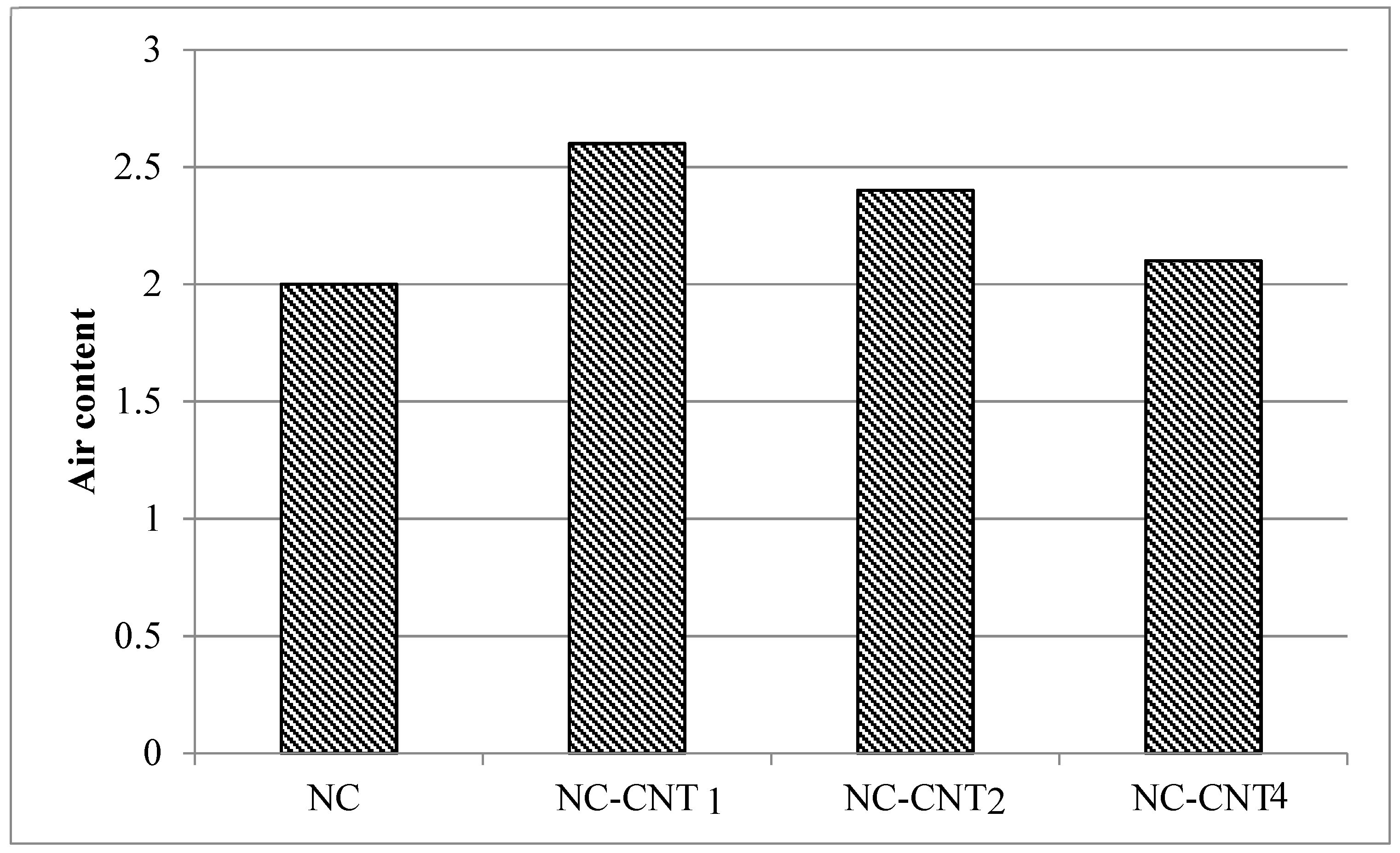


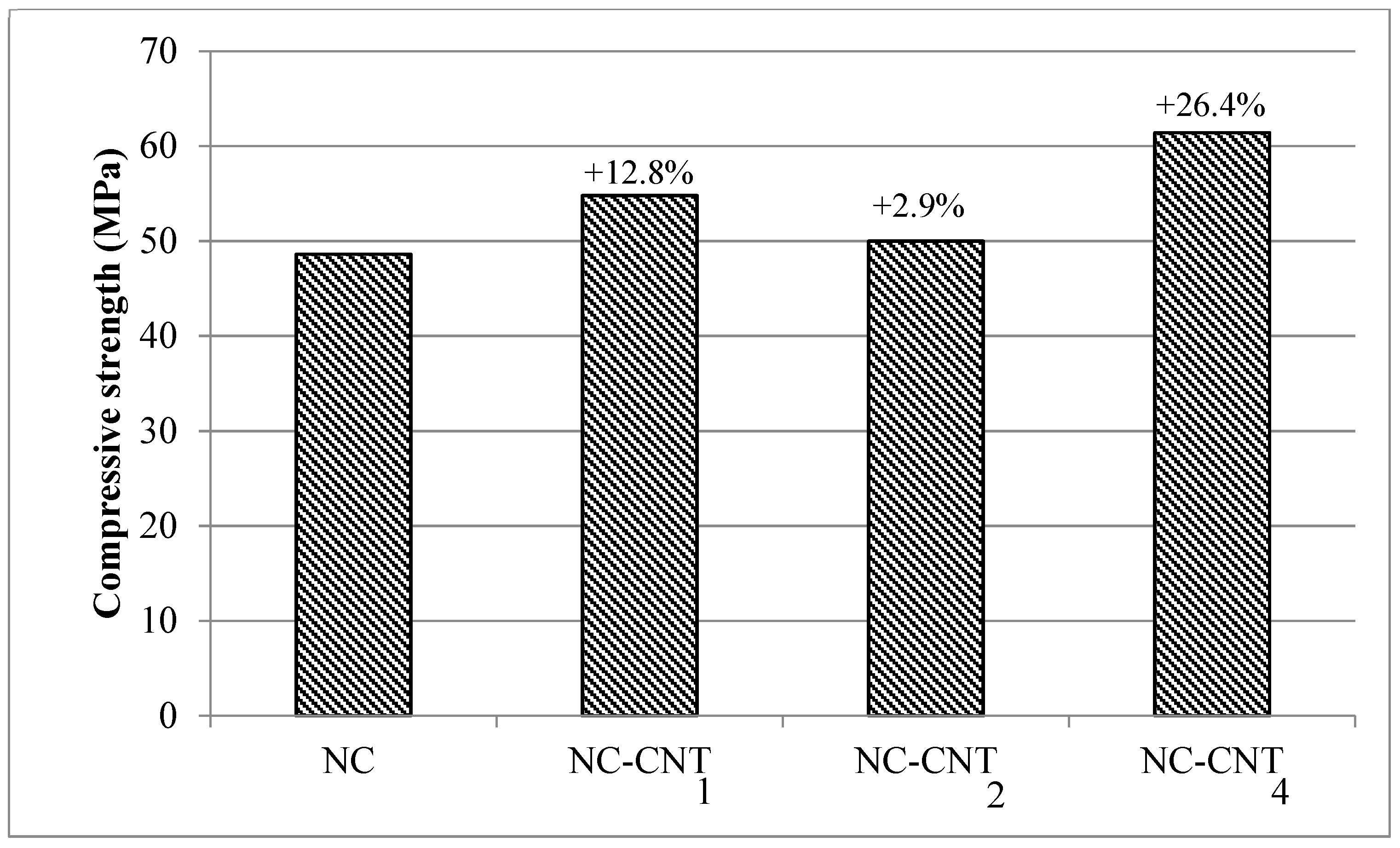
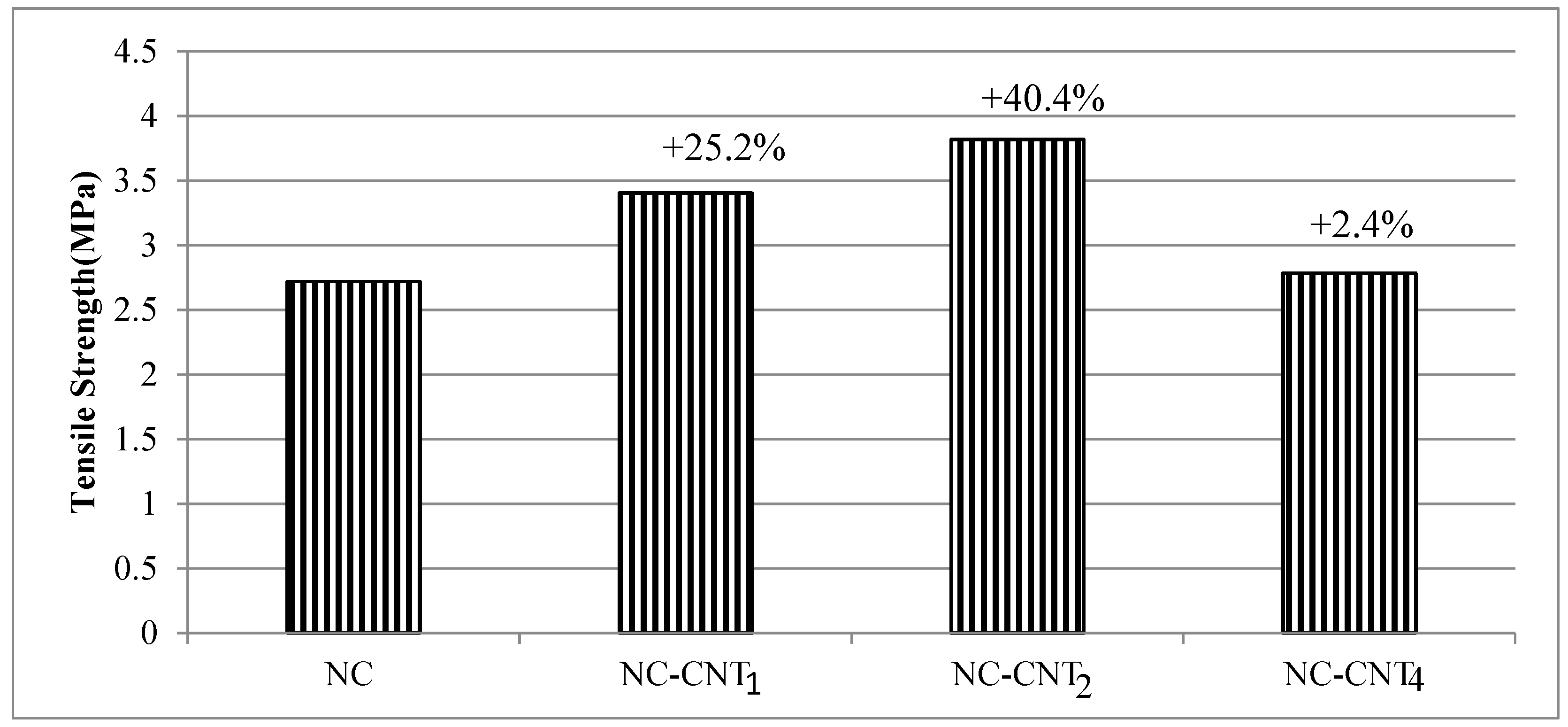
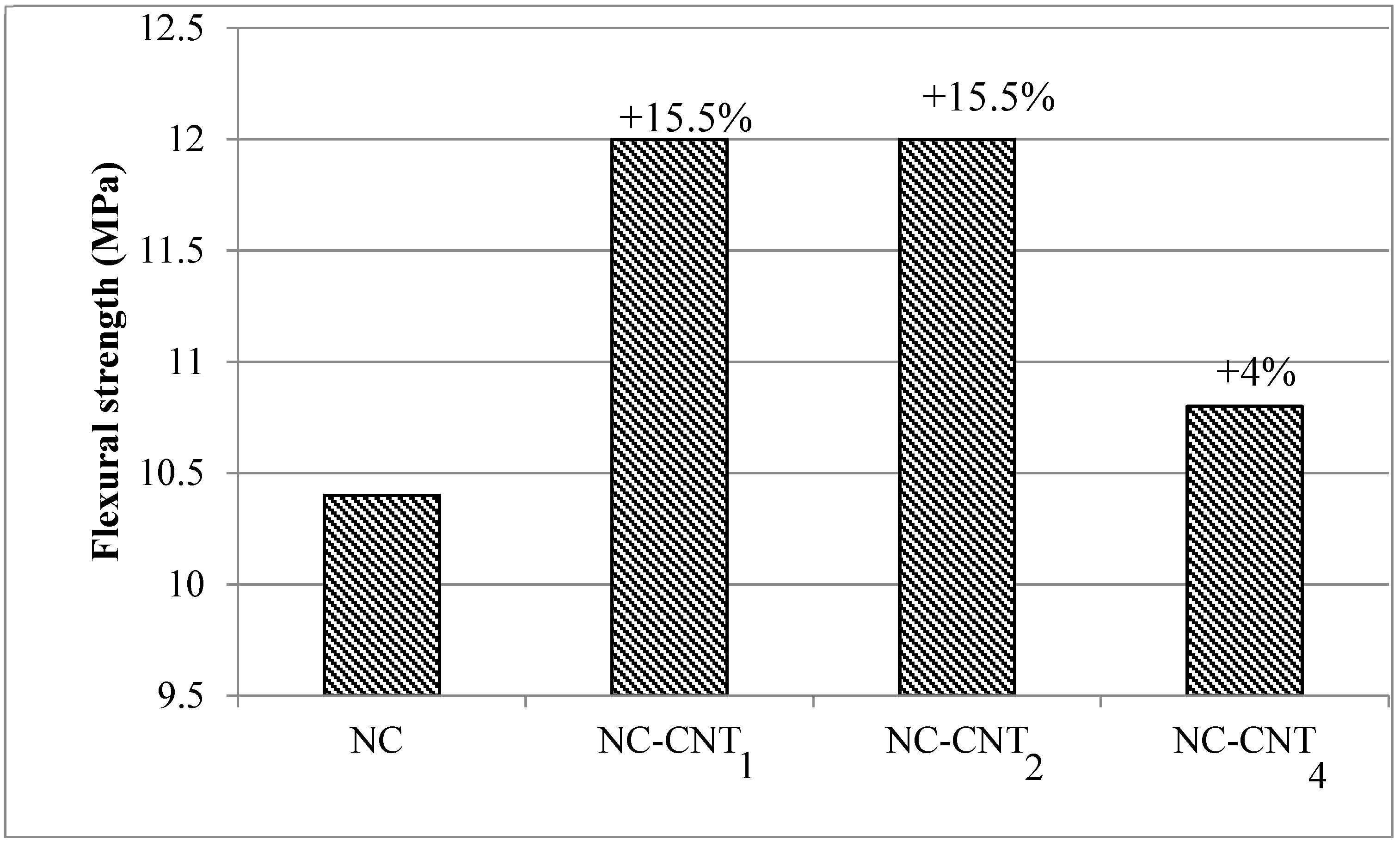
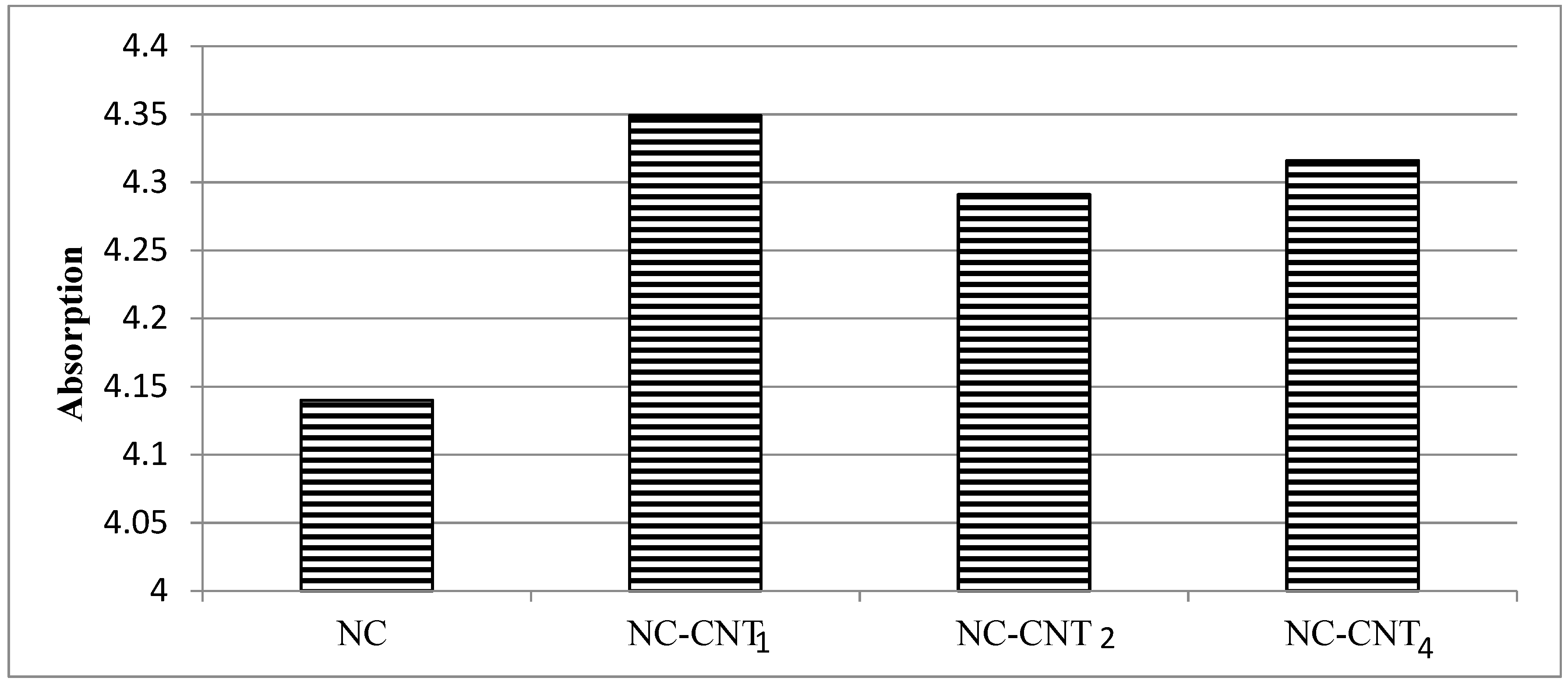
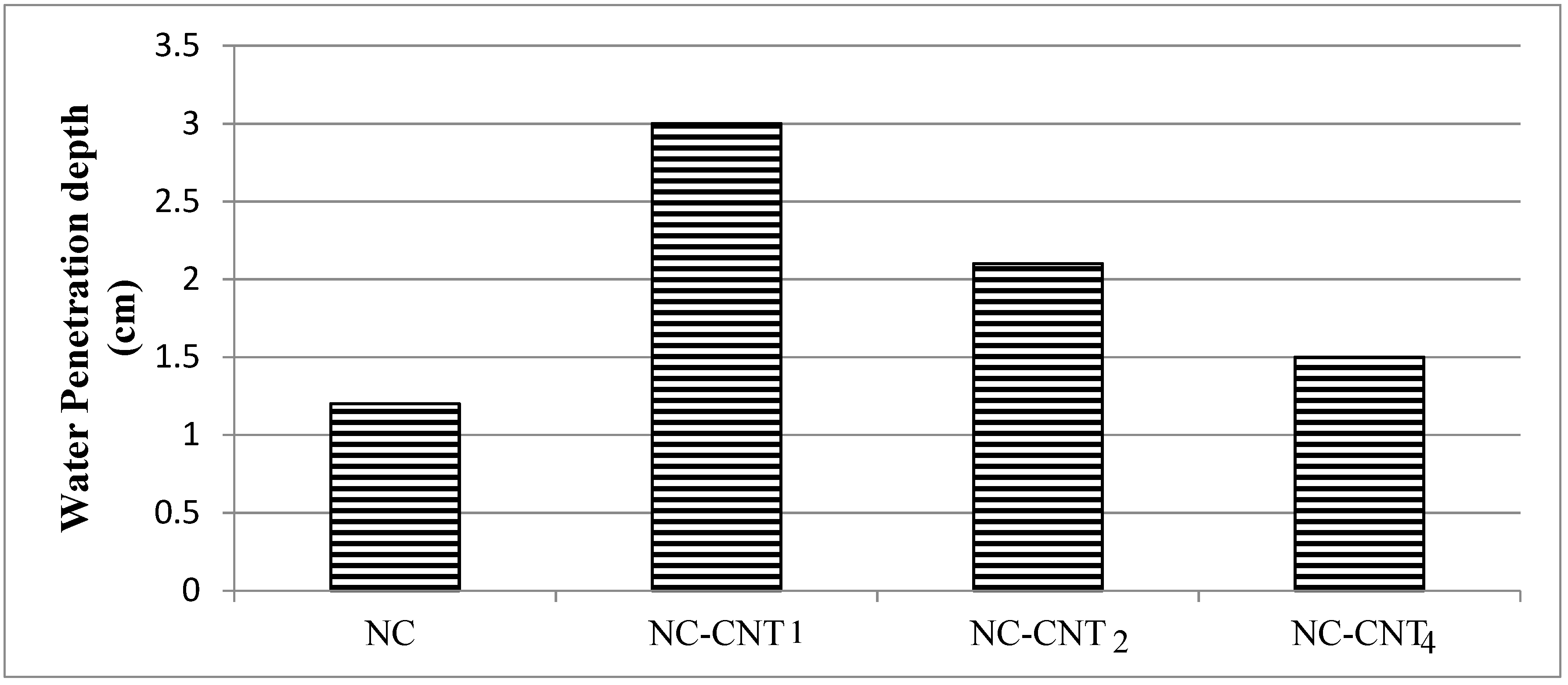
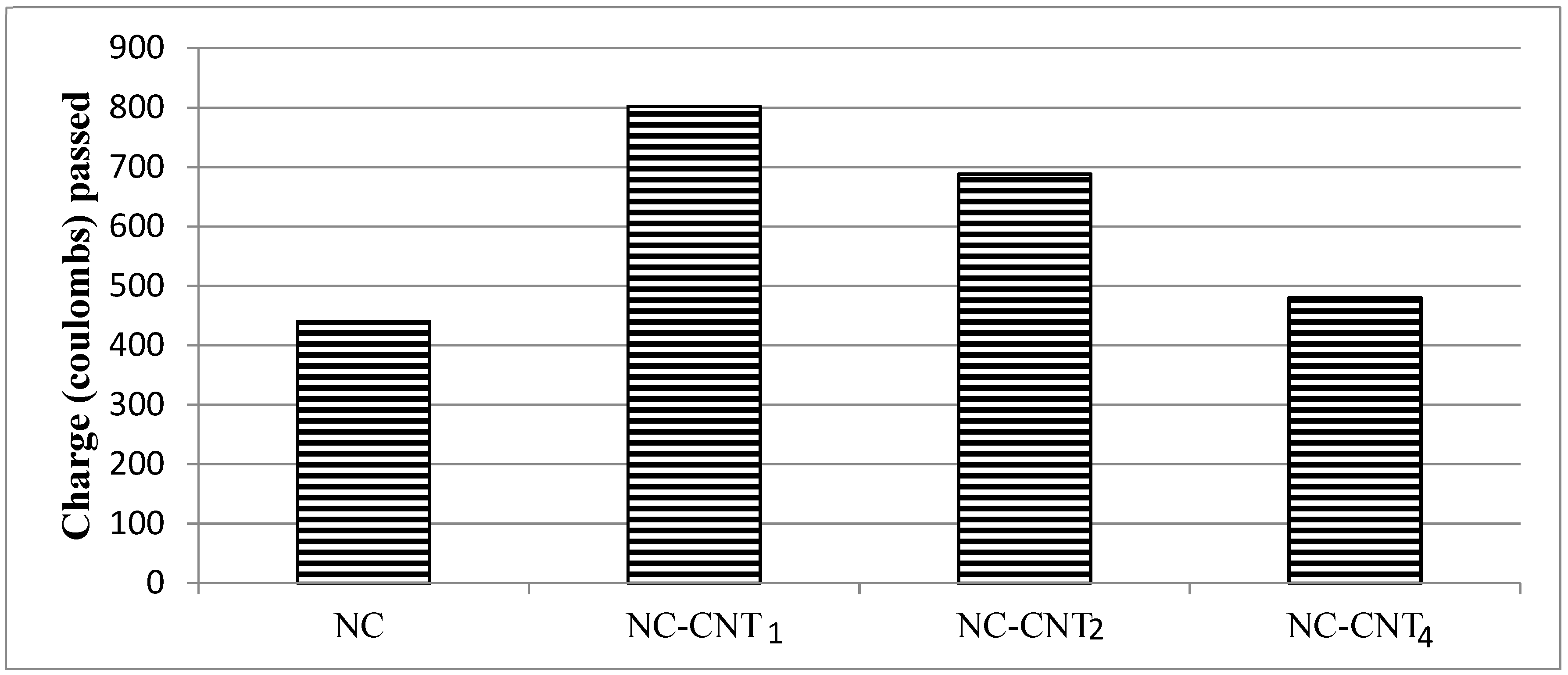


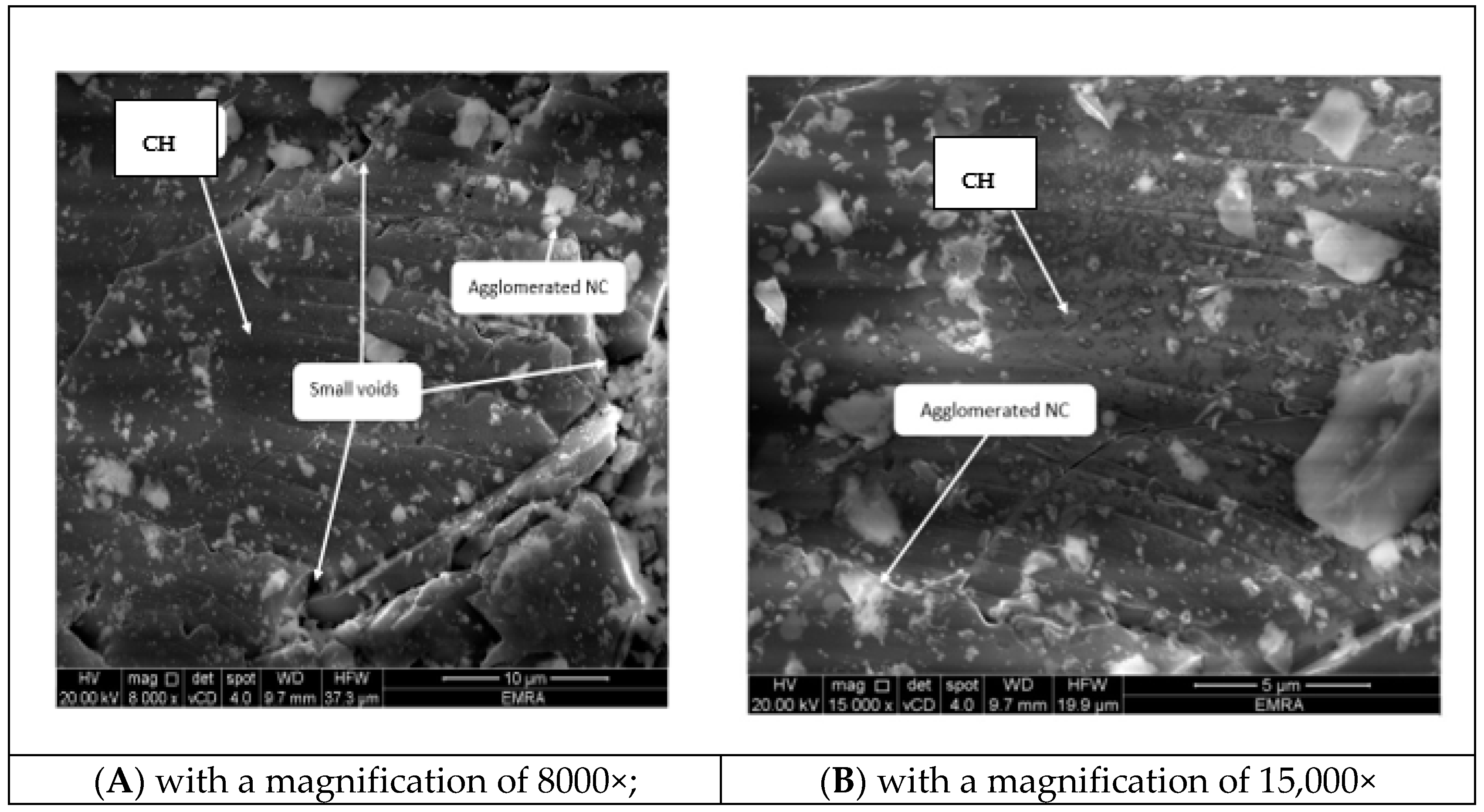
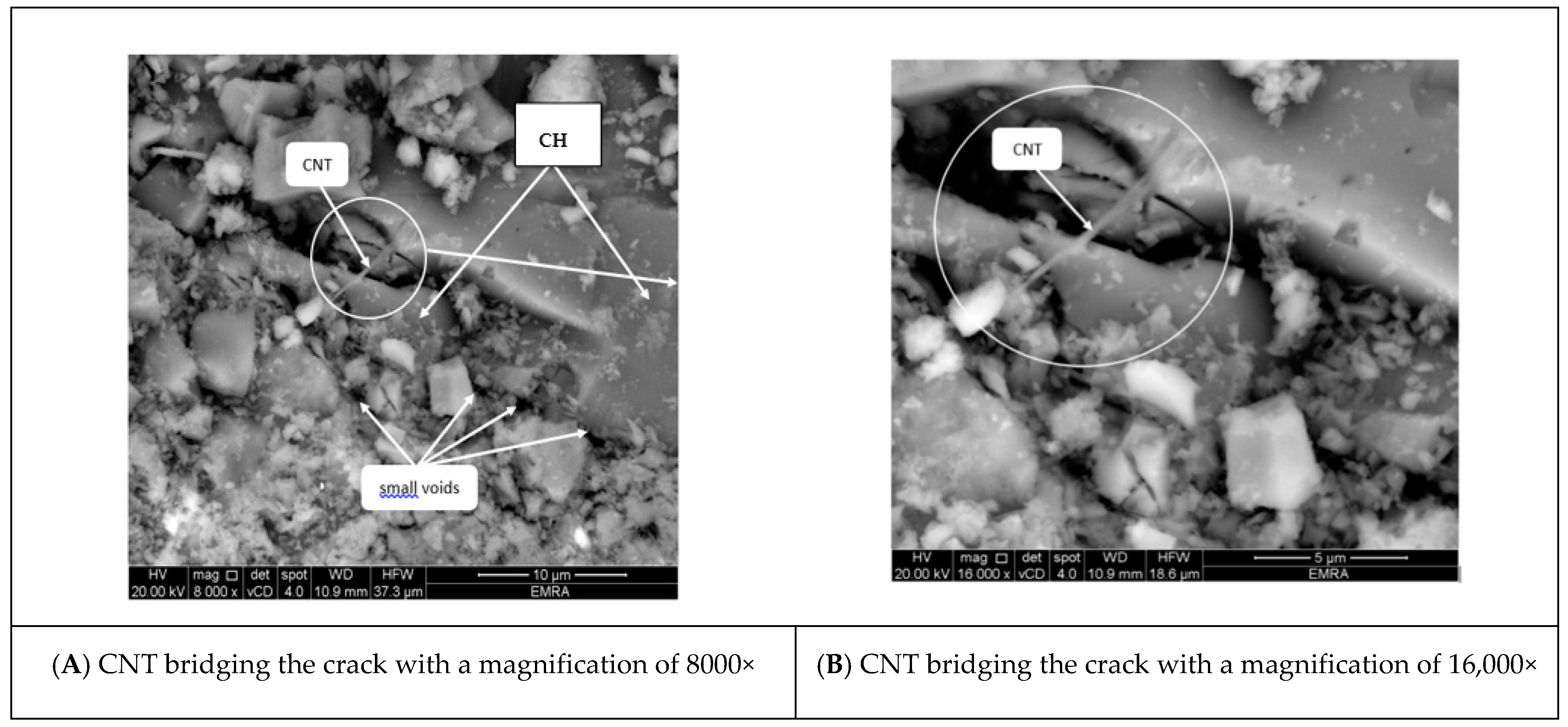
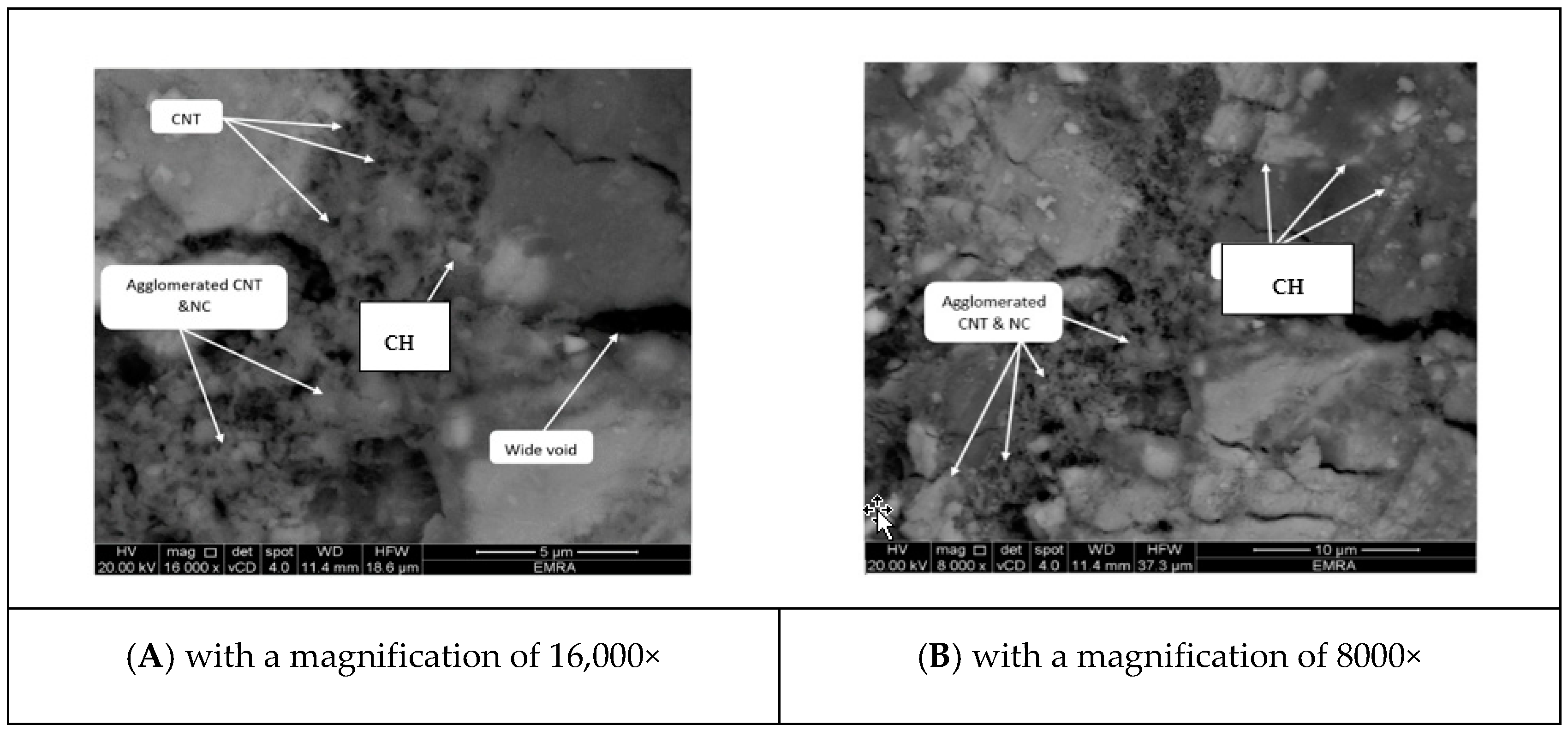
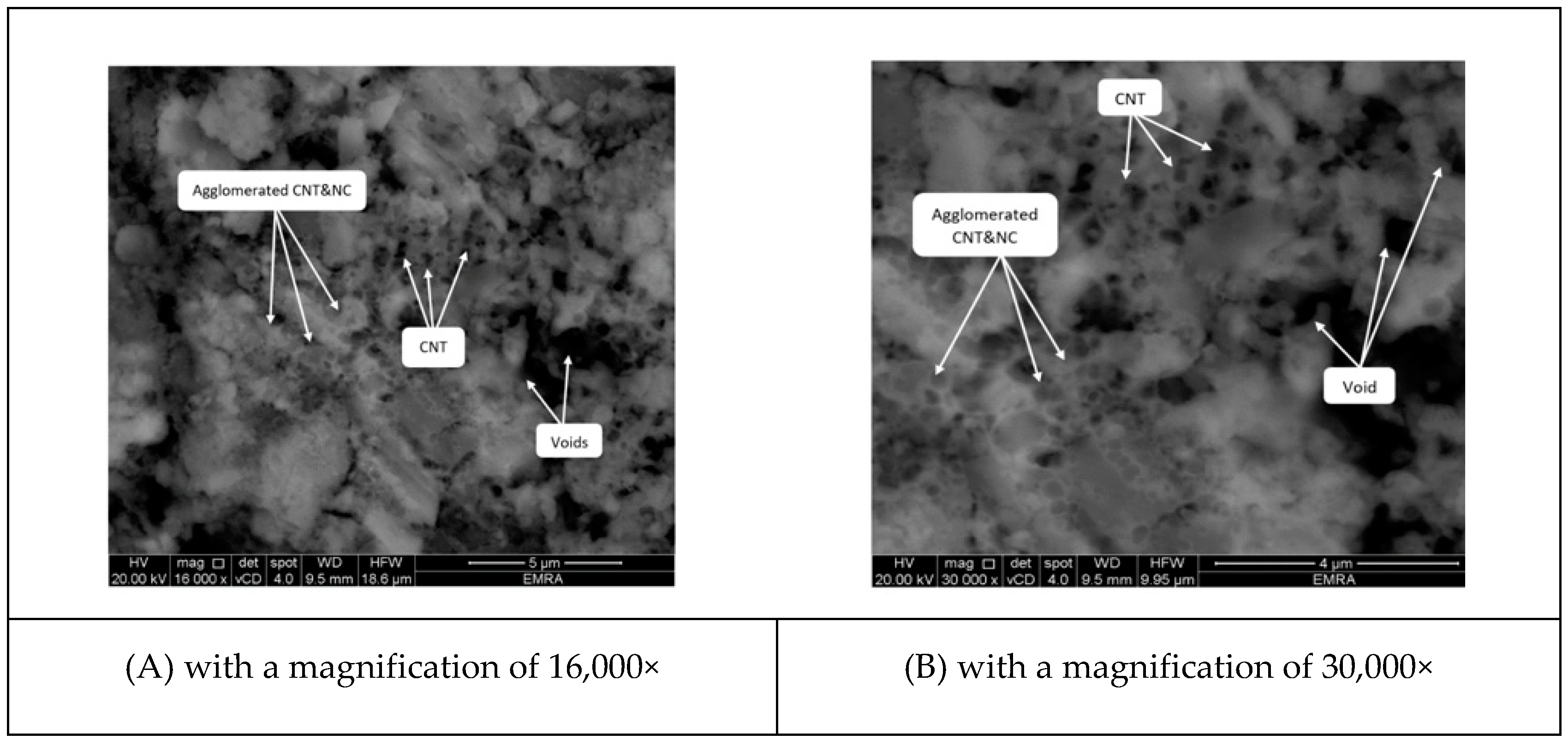
| Element | SiO2 | Fe2O3 | Al2O3 | CaO | MgO | TiO2 | Na2O | L.O.I |
| Content % | 61.24 | 1.06 | 20.89 | 0.16 | 0.22 | 1.61 | 0.71 | 13.12 |
| Appearance | Brown free-flowing liquid |
| Specific gravity@24 °C | 1.190 |
| Air-entrainment | Maximum 1% |
| Nitrate content (%) | Nil |
| Chloride content (%) | Nil to BS 5075 |
| Mix ID | Cement | NC | CNT | Fine Aggregate | Coarse Aggregate | Water | S.P |
|---|---|---|---|---|---|---|---|
| NC | 427.5 | 22.5 | - | 597 | 1109 | 192 | 5.4 |
| NC-CNT1 | 427.46 | 0.045 | |||||
| NC-CNT2 | 427.41 | 0.09 | |||||
| NC-CNT4 | 427.32 | 0.18 |
Publisher’s Note: MDPI stays neutral with regard to jurisdictional claims in published maps and institutional affiliations. |
© 2021 by the authors. Licensee MDPI, Basel, Switzerland. This article is an open access article distributed under the terms and conditions of the Creative Commons Attribution (CC BY) license (http://creativecommons.org/licenses/by/4.0/).
Share and Cite
Gamal, H.A.; El-Feky, M.S.; Alharbi, Y.R.; Abadel, A.A.; Kohail, M. Enhancement of the Concrete Durability with Hybrid Nano Materials. Sustainability 2021, 13, 1373. https://doi.org/10.3390/su13031373
Gamal HA, El-Feky MS, Alharbi YR, Abadel AA, Kohail M. Enhancement of the Concrete Durability with Hybrid Nano Materials. Sustainability. 2021; 13(3):1373. https://doi.org/10.3390/su13031373
Chicago/Turabian StyleGamal, Heba A., M. S. El-Feky, Yousef R. Alharbi, Aref A. Abadel, and Mohamed Kohail. 2021. "Enhancement of the Concrete Durability with Hybrid Nano Materials" Sustainability 13, no. 3: 1373. https://doi.org/10.3390/su13031373
APA StyleGamal, H. A., El-Feky, M. S., Alharbi, Y. R., Abadel, A. A., & Kohail, M. (2021). Enhancement of the Concrete Durability with Hybrid Nano Materials. Sustainability, 13(3), 1373. https://doi.org/10.3390/su13031373






